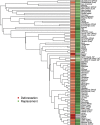Cultural and Environmental Predictors of Pre-European Deforestation on Pacific Islands
- PMID: 27232713
- PMCID: PMC4883741
- DOI: 10.1371/journal.pone.0156340
Cultural and Environmental Predictors of Pre-European Deforestation on Pacific Islands
Abstract
The varied islands of the Pacific provide an ideal natural experiment for studying the factors shaping human impact on the environment. Previous research into pre-European deforestation across the Pacific indicated a major effect of environment but did not account for cultural variation or control for dependencies in the data due to shared cultural ancestry and geographic proximity. The relative importance of environment and culture on Pacific deforestation and forest replacement and the extent to which environmental impact is constrained by cultural ancestry therefore remain unexplored. Here we use comparative phylogenetic methods to model the effect of nine ecological and two cultural variables on pre-European Pacific forest outcomes at 80 locations across 67 islands. We show that some but not all ecological features remain important predictors of forest outcomes after accounting for cultural covariates and non-independence in the data. Controlling for ecology, cultural variation in agricultural intensification predicts deforestation and forest replacement, and there is some evidence that land tenure norms predict forest replacement. These findings indicate that, alongside ecology, cultural factors also predict pre-European Pacific forest outcomes. Although forest outcomes covary with cultural ancestry, this effect disappears after controlling for geographic proximity and ecology. This suggests that forest outcomes were not tightly constrained by colonists' cultural ancestry, but instead reflect a combination of ecological constraints and the short-term responses of each culture in the face of those constraints.
Conflict of interest statement
Figures


References
-
- Firth R (1936) We, the Tikopia. London: George Allen and Unwin.
-
- Kirch PV (1994) The wet and the dry: irrigation and agricultural intensification in Polynesia Chicago: University of Chicago Press; xxii, 385 p. p.
-
- Rolett B, Diamond J (2004) Environmental predictors of pre-European deforestation on Pacific islands. Nature 431: 443–446. - PubMed
-
- Diamond JM (2005) Collapse: how societies choose to fail or succeed New York: Viking; xi, 575 p., 524 p. of plates p.
-
- Kirch PV, Rallu J-L (2007) The growth and collapse of Pacific island societies: archaeological and demographic perspectives Honolulu: University of Hawaiʻi Press; xvi, 390 p. p.
MeSH terms
LinkOut - more resources
Full Text Sources
Other Literature Sources

